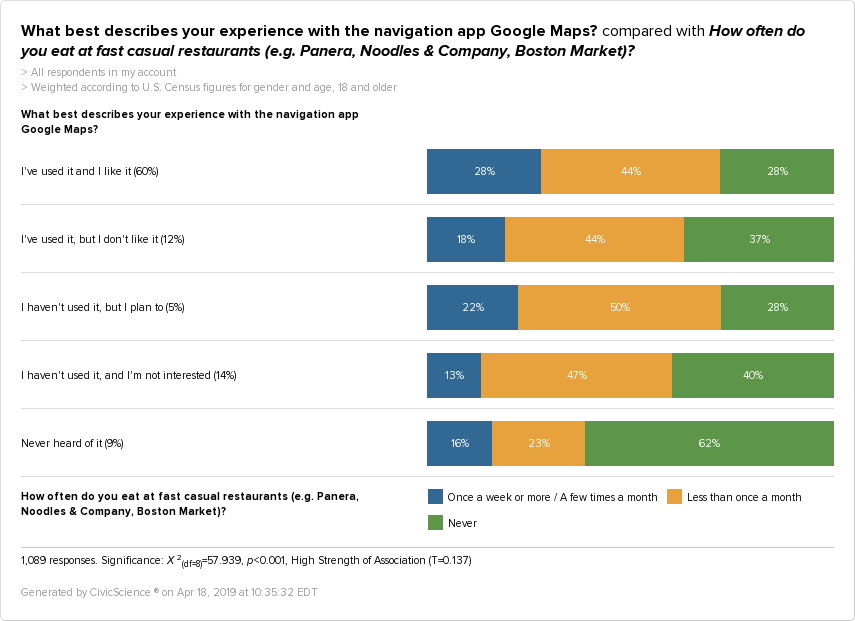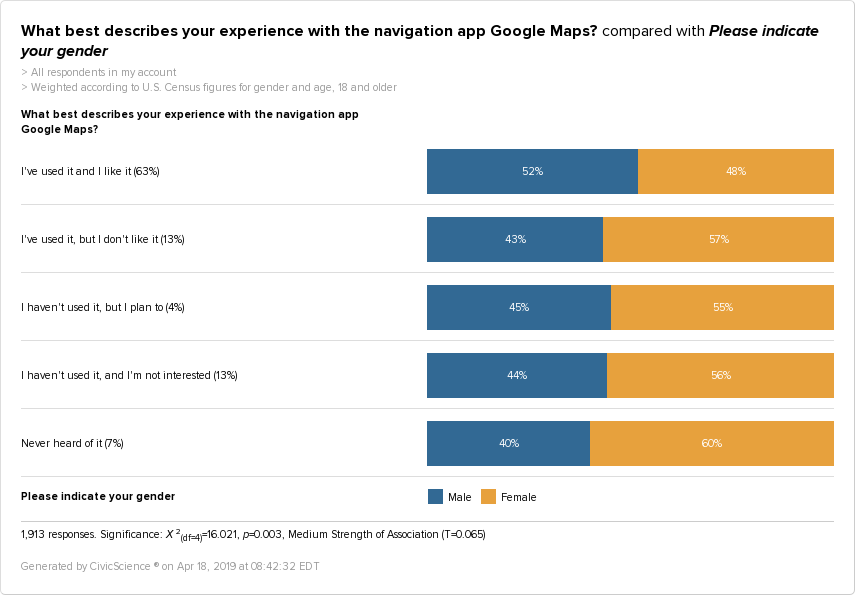Google is already a powerhouse for marketers when it comes to search marketing, and they’ll only be increasing that status as they expand their advertising offerings on one of their popular platforms, Google Maps. Google plans to ramp up this channel for advertising through promoting sponsored locations/businesses — perhaps ones that are near you given the indication from your smartphone’s location services, based on what you’re already searching for in the moment, or using data gleaned from other Google products in the past.
Google’s own 2017 data showed that mobile searches with “near me” or “can I buy” had increased by 500% over the course of the prior 2 years. That fact, coupled with how Google Maps is already so widely used by the U.S. adult population makes it a prime new opportunity for marketers. CivicScience surveyed over 1,900 U.S. adults on their experience with Google Maps to measure awareness, likeability, and intent:
Over 60% of U.S. adults indicate they’re Google Maps users who like the service, and 13% don’t like it. That means that, out of those who’ve tried the app, about 18% aren’t happy with it. And, only 13% of respondents aren’t interested in using it at all, but an additional 11% either plan to use it or haven’t heard of Google Maps – meaning that this user base could become even more expansive. As the user base grows, it’s likely that favorability will grow.
We’ve uncovered some factors that new or existing advertisers on the platform should consider when making media decisions and also researched the demographics of Google Map users.
Advertising considerations
A positive note for advertisers is that Google Maps users are more likely to frequently research products they want to purchase using their smartphone. This is promising since Google plans to continue to personalize ads on an individual basis using data from other searches or Google products.
Taking a deeper look, the study also identified Google Maps users’ tendencies to visit different types of businesses that could be prime candidates for Google Maps promos:
Fast food and quick service restaurants can stand to benefit from local Google Maps promotions. The study found that favorable Google Maps users are more likely to frequent fast food restaurants (once a week or more / a few times a month) than those who’ve used it but don’t like it. Users are also more likely to say they dine at fast casual restaurants less often.
Given the Google-reported increase in search results that include phrases like “can I buy” and “where can I buy” when users are searching for specific products, Google Maps could be an important advertising channel for grocery stores selling more general items. Those who shop at a supercenter retailer (such as Walmart or Target) for most grocery related purchases are more likely to say they haven’t used Google Maps and aren’t planning to do so. However, 34% of those who do plan to use Google Maps do most of their grocery shopping at small, local, independent grocery stores. If the intent group grows, this could have implications for local stores to explore Google Maps as a promotion option.
On the same note, the local aspect already seems to be important to current Google Maps users – they’re more likely than those who don’t like Google Maps and those who aren’t interested in using it to say that shopping local is very or somewhat important to them. Seems there will be additional opportunities for local businesses to capture more eyes.
Demographics
While Google continues to roll out these new offerings, demographics will be an important consideration:
71% of Gen Xers are favorable Google Maps users.
While it’s fairly close, men make up more of the Google Maps user base.
As it stands, fast food companies and local businesses have opportunities ahead when it comes to local search advertising. We can expect that Google Maps will continue to advance their offerings – both to advertisers and app users. We’ll be tracking how impactful the navigation app’s ads are through our trend watch methodology and keep an eye on this channel as it evolves.
















